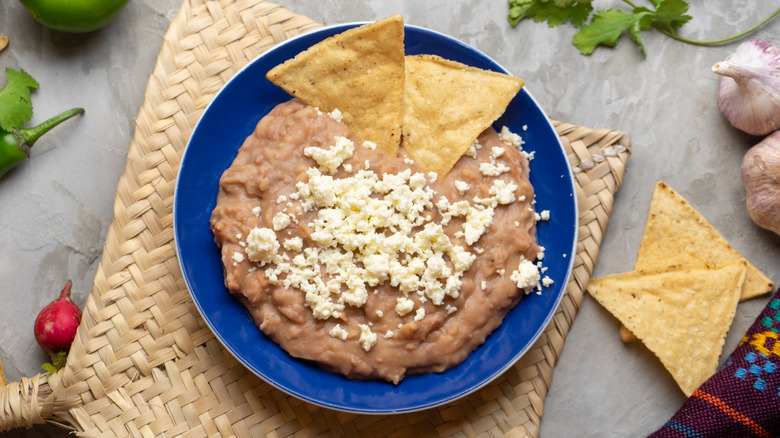Why Refried Beans Taste Better In A Restaurant Than At Home
For homemade taco or enchilada nights, refried beans are both integral and an afterthought; we focus our attention on the main dish, and heat a can of refried beans on the stove five minutes before we're ready to eat. While canned refried beans are convenient, they're no match for the creamy and flavorful refried beans served at your local Mexican restaurant.
If you're wondering what is the secret ingredient for restaurant-quality refried beans, the answer is fat. Restaurant-made refried beans honor traditional Mexican culinary practices by adding a hearty helping of lard or bacon fat drippings to their recipe. It's no secret that fat correlates to flavor, as every culinary culture uses butter, oils, or shortening to create a flavorful foundation for recipes ranging from salad dressings to desserts.
Made from rendered pork fat, lard became a crucial part of Mexican cooking when pigs were introduced to Mexican soils by the Spanish. It's the base of many popular recipes from tamales to flour tortillas. While lard has been replaced with vegetable oil or shortening in many households, the distinct richness and velvety texture it imparts to a skillet of refried beans is hard to beat. The closest substitute for lard is bacon grease, which is another form of rendered pork fat that's arguably even more flavorful. That said, crema, butter, olive oil, and vegetable oil will all enhance the consistency and richness of refried beans.
Tips for transforming canned or scratch-made refried beans into restaurant-worthy sides
If you want to make restaurant-worthy refried beans, you can either start from scratch or doctor a can of store-bought beans. If you start with dried beans, you can build a foundation for the broth with chopped bacon, seasonings, and aromatics as they're slow cooking. Then you'll mash the beans in a skillet with a few tablespoons of the flavorful broth and a spoonful of lard to create ultra-savory, ultra-smooth refried beans.
If you're doctoring a can of refried beans, you'll likewise add a spoonful of lard, bacon grease, or butter. However, considering the thickness of canned refried beans, you might want to add a bit of broth or water, plus seasonings like garlic or onion powder, salt, and pepper. Another option is to add a splash of heavy cream or a dollop of sour cream.
Whether you're using scratch-made or canned beans, a saucepan or skillet is ideal for easier emulsion. If the beans are too thin, a longer stint bubbling in the skillet will evaporate excess liquid for a thicker consistency. The longer they bubble, the drier and thicker they'll get. You might also notice a dry layer of beans forming on the bottom of the skillet. You can use this dried layer to bolster the flavor and consistency of the dish. Simply scrape the dried bits with a spatula and incorporate them back into the beans for a toasty crunch and smoky finish.

